FURUNO VOYAGER, the next-generation bridge system
FURUNO VOYAGER, next-generation bridge system, has been designed using our decades of expertise in sensor devices, network integration and software development. FURUNO VOYAGER bridge system offers multifunction workstations with seamless display of Radar/Chart Radar, ECDIS, Conning and Alert Management System data. FURUNO VOYAGER bridge systems have been developed with a completely new and intuitive user interface and in strict accordance with the most up-to-date safety and navigation standards in mind.
Total network sensor integration delivers enhanced situational awareness to the mariner. An uncomplicated display presentation simplifies and streamlines navigational tasks. Common responsibilities such as route planning, navigation status monitoring, log-keeping, alarm awareness and day-to-day chart management are made easy through common workstation layout and redundancy of display and control. Watchstanders will enjoy reduced workload and significant freedom to move about the bridge, with all necessary information available in a variety of displays and locations.
Features
Multifunction display (MFD) capability
FURUNO VOYAGER offers workstations that combine flexibility and redundancy. Users may easily select ECDIS, Radar/Chart Radar, Conning display or Alert Management System at any multifunction display. Navigators will enjoy reduced workload and significant freedom to move about the bridge, with all necessary information available in a variety of displays and locations.
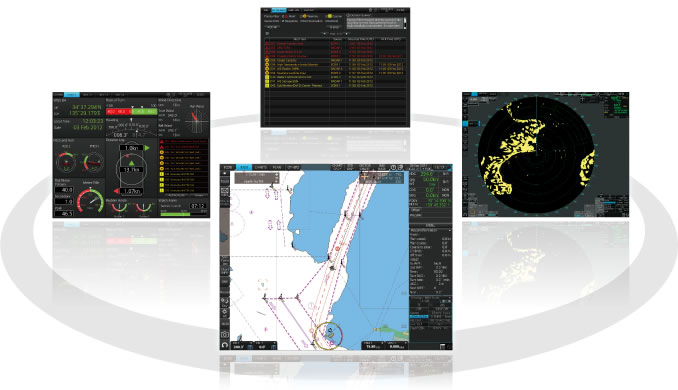
ECDIS mode
In ECDIS mode, the operators can generate and edit route plans. Also, ship’s behavior can be monitored in relations to the planned route. The detailed parameters set for each waypoint within the route can be viewed in the route information window.
» Read more
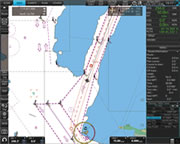
Radar/Chart Radar mode
In Radar/Chart Radar mode, the operators can monitor radar image around the ship, hence enhancing their situational awareness with information about the nearby objects above the sea surface. It is a powerful tool for collision avoidance while the ship is underway.
» Read more
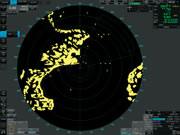
Conning mode
In the Conning display mode, sensor information and real-time navigation data are presented to navigators in a thoughtfully designed display presentation.
Information to be shown in the conning display:
- Heading
- Pitch and Roll
- Rudder angles
- Rate of Turn
- Position fix
- Speed (bow speed, longitudinal speed and stern speed)
- Propeller pitch
- Wind speed and direction (both true and relative)
- Thrusters pitch
- Alert list
- BNWAS indication
- Date and time, etc.
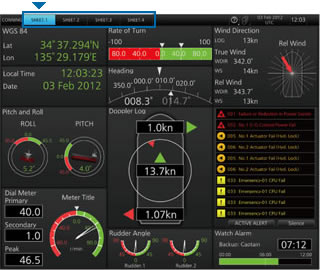
Alert Management System mode
Alert Management System presents and prioritizes alert status and information. The well designed display layout gives operators the ability to quickly identify alert situations, and the actions required to rectify the cause of the alert.
The Alert management System satisfies MSC.302(87) Performance Standards for Bridge Alert Management.
ACTIVE ALERT
List of alerts currently active can be viewed.

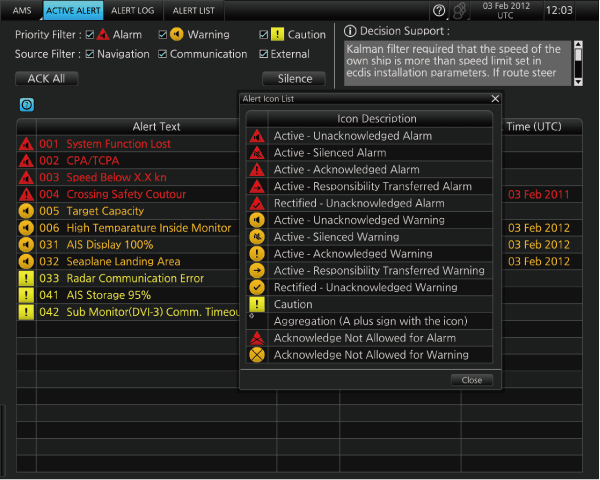
By clicking on the ![]() in the ACTIVE ALERT page, the list of icons used in the Alert Management System and their descriptions can be shown as a pop-up window.
in the ACTIVE ALERT page, the list of icons used in the Alert Management System and their descriptions can be shown as a pop-up window.
ALERT LOG
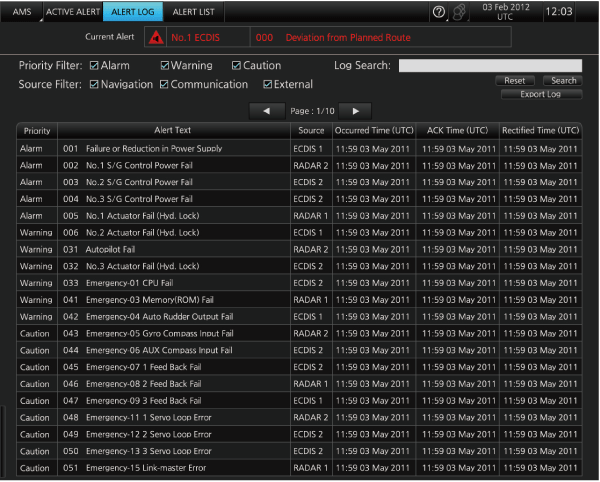
Alert history can be viewed in chronological order. The source of alerts, and the date and time each alert was raised, acknowledged and rectified are shown.
ALERT LIST
List of alerts available for each alert source can be viewed.
Track Control System permits automatic steering along the set route
FURUNO VOYAGER features Track Control System through integration of ECDIS and autopilot. This enables the vessel to keep on the plotted route automatically with minimum intervention from the navigator. This has been achieved through:
- flexible steering control
- route planning on ECDIS
- enhanced position reliability through multi-tiered data validation process
The operator is alerted to navigational warnings and potential dangers before the vessel is at risk.
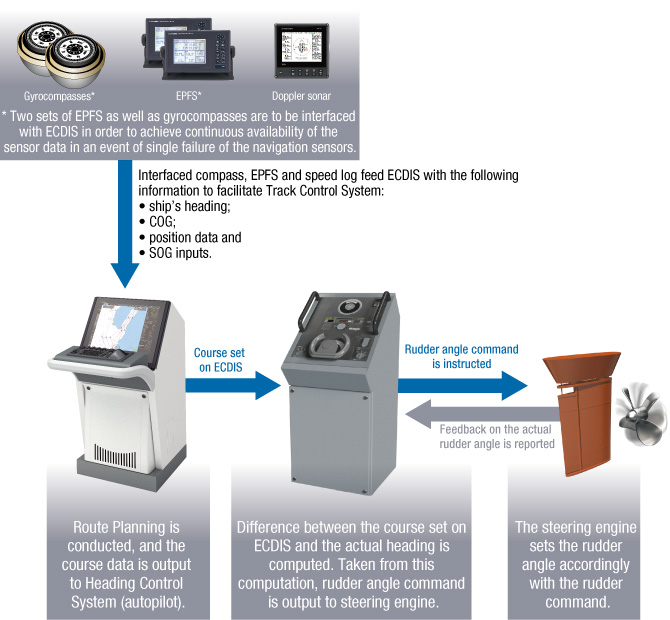
FURUNO’s new user interface delivers straightforward, task-based operation
Stress-free operation with the well-designed control units

- Common key assignment is arranged for the common tasks, such as EBL, VRM controls, on the control units of ECDIS and Radar/Chart Radar
- Operation scheme close to a PC with the use of the trackball.
Trackball: to move the cursor and select an object
Left-click: to perform/con.rm the action related to the selected object
Right-click: to display contextual menu while cursor is on the display area, and to cancel action done on the selected object
Scrollwheel: to select menu items - ECDIS Control Unit : Full QWERTY keyboard for easy entry of route, event and waypoint names.
Radar Control Unit : Functions specific to Radar can be carried out.
Contextual menu
Contextual menu contains all the available actions related to the position of the cursor, hence providing quick access to the tasks required.
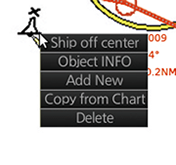
ECDIS
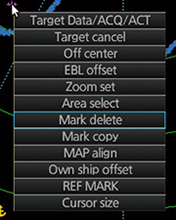
RADAR
Task-based user interface by combination of Status bar and InstantAccess bar
FURUNO VOYAGER user interface includes carefully organized operational tools designed to make navigational tasks simple and easy. The “Status Bar” at the top of the screen clearly indicates operating mode and status and offers direct single-click control of the navigator’s principle tasks. The “Instant Access” bar at the left of the screen provides direct control of the features and attributes of the on-screen presentation. These on-screen tools deliver straightforward, task-based operation with all multi-function display information in view at all times. The operator can quickly perform navigational tasks without having to enter intricate menus, thus losing situational awareness.
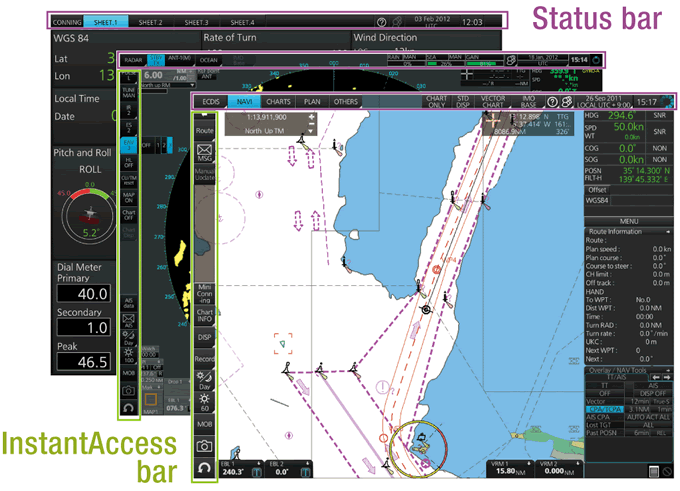
InstantAccess knob
Rotating and pressing InstantAccess knob leads the operator easily to the items in the InstantAccess bar.
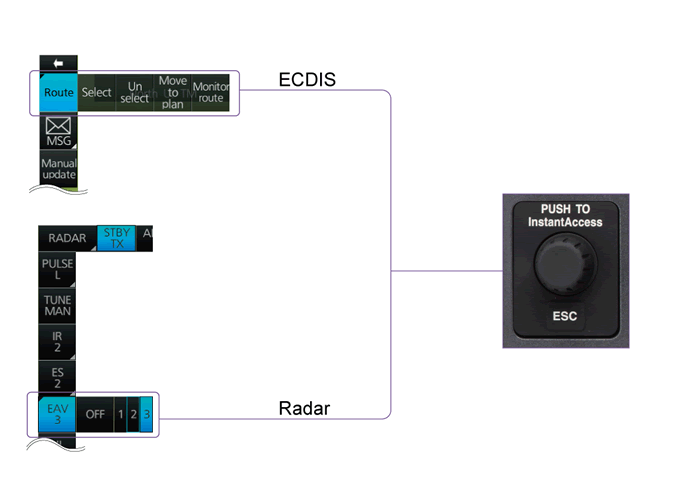
Network Configuration
FURUNO VOYAGER onboard navigation network system
FURUNO VOYAGER integrates the following two separate networks that link all the onboard navigation equipment, including multifunction displays and various sensors: Network for Integration and Interswitch and Network for Sensor Integration.
The navigation system consists of duplicated subsystems so that any loss of navigational functions can be avoided in an event of single point of failure. Since MFD is able to function as Radar, ECDIS, conning information display and alert management system, navigation tasks can be performed from any of the interfaced multifunction displays, hence optimizing the system availability.
Network for Integration and Interswitch (Gigabit Ethernet) is used to communicate the following data:
- Radar interswitching
- TT and AIS target data
- Harmonization of database (charts, routes, etc.)
Network for Sensor Integration (combination of 100 Base-TX Ethernet and IEC 61162-1/IEC 61162-2) is used to communicate the following data:
- Sensor data
- Alert information
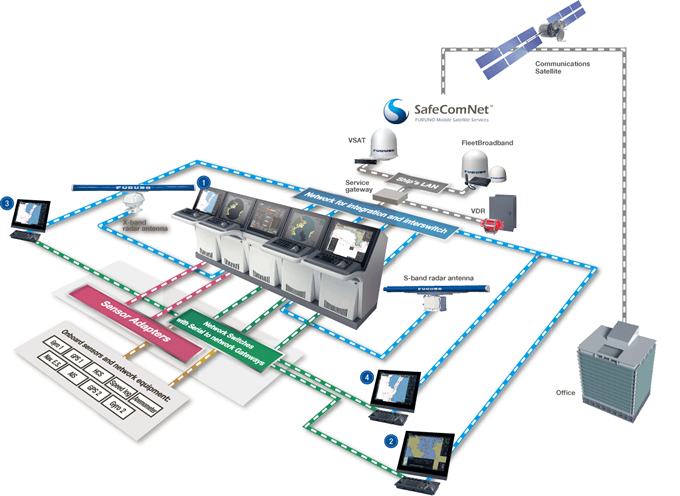
- Multifunction displays operating as X-/S-band radar, ECDIS, Conning Information Display and Alert Management System
- Multifunction display for Route planning workstation
- Multifunction display for Wing workstation (port side)
- Multifunction display for Wing workstation (Starboard side)
Sensor adapter
Sensor adapters act as central medium to gather all the sensor data and collectively feed it to all the workstations within the system. Individual cablings in the sensor-to-workstation interface can be greatly reduced. Since arrangement of the sensor adapters can be customized and extended to cover all the sensors within the system, thanks to its component configuration, flexibility can be assured when planning the network structure of the bridge system.
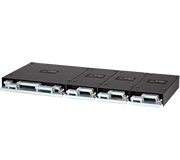


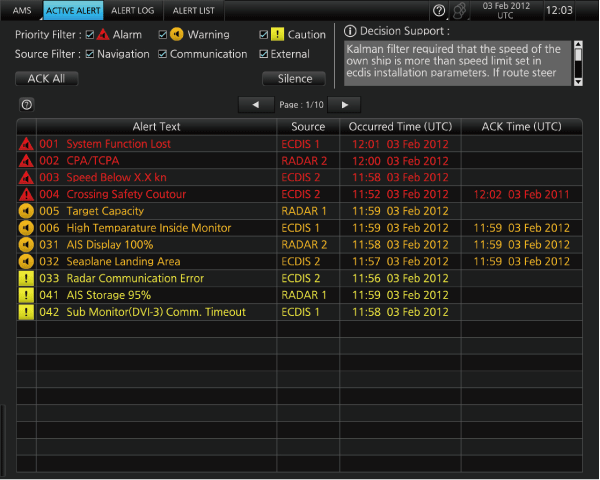








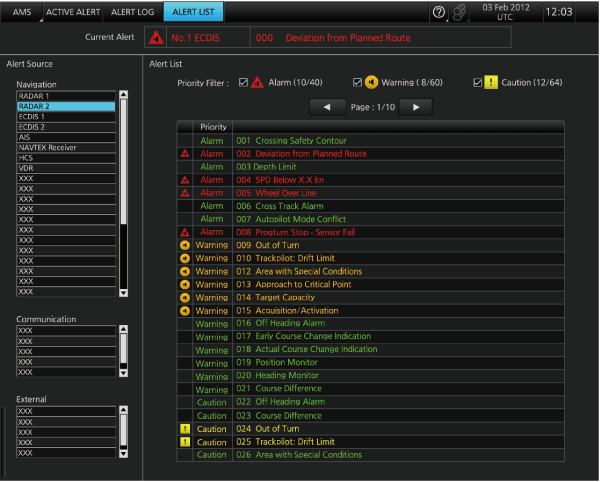


 FURUNO VOYAGER Brochure
FURUNO VOYAGER Brochure DEEPSEA WORLD (For Merchant Marine)
DEEPSEA WORLD (For Merchant Marine)